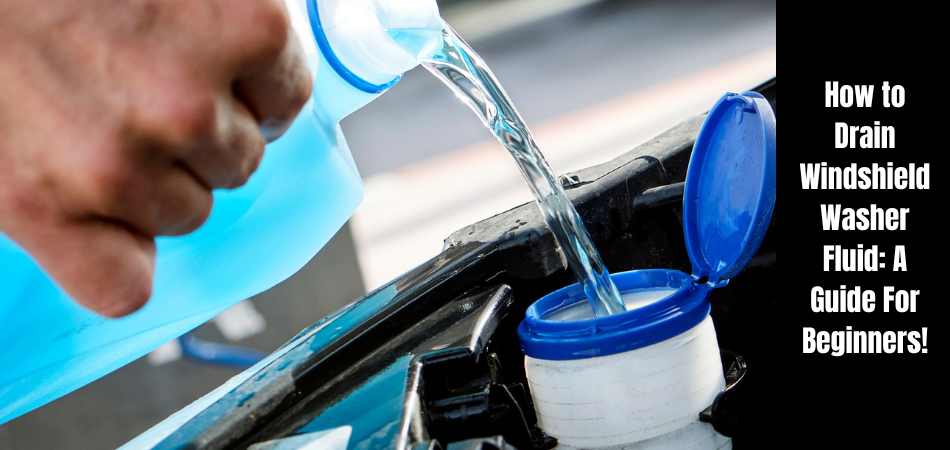
A windshield is one of the most essential parts of a car. It provides protection against wind, rain, and debris for the driver and passengers. Additionally, the windshield allows you to see the road clearly. But How to Drain Windshield Washer Fluid?
When the windshield gets dirty, windshield washer fluid is used to clean it. As time passes, dirt and grime can accumulate in the washer fluid. The windshield washer fluid should be drained and replaced when this occurs.
Once the windshield washer fluid has been drained, locate the reservoir. A reservoir is usually found near the firewall of the engine compartment. Pour the old fluid out of the reservoir and flush it with distilled water once you have seen it. You will need to connect the hose to the reservoir and refill it.
What Is Windshield Washer Fluid Composed Of?
Small amounts of methanol and other chemicals are found in washer fluid. Consequently, children and pets should stay away from the fluid. Depending on how much fluid is ingested, it might cause coma, permanent blindness, and death if it is ingested in small amounts.
You should also keep in mind that windshield washer fluid is an essential fluid for your vehicle.
What are the Benefits Of Washer Fluid?
The windshield washer fluid in your car dissolves grit and dirt on your windshield without you having to use soap. It is impossible to remove grime with simple water.
Mold and bacteria can grow in the fluid during the winter, which is dangerous to the driver and passengers. Regular cleaning and refilling of the washer fluid tank is necessary to avoid bacteria manifestation.
Additionally, washer fluid contains antifreeze elements that prevent pipe bursts and cracks.
How Is Washer Fluid Ejected/Applied?
The same lever that turns on the wipers in your vehicle applies windshield washer fluid. Windscreen washer fluid jetted onto the windscreen by pulling up the lever. A motor and windshield washer assembly are the internal components of this jet.
What are the Causes of a Bad Windshield Washer Pump?
1. Nozzles clogged with debris
When the washer fluid can’t reach the windshield, it’s time to clean the washer nozzles. Remove any debris from the holes with a needle or pin, and then use compressed air to clean them out. Disassemble the nozzles and soak them in vinegar overnight if that doesn’t work.
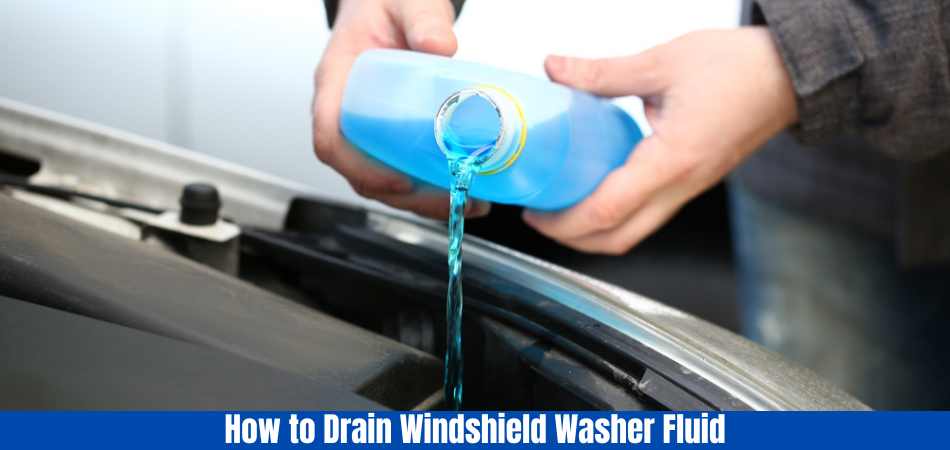
2. Hose leaks
A leak in one of the hoses is the most common cause of a washer pump failure. If necessary, replace the hoses if they have cracks or leaks. Fixing a frayed or split hose is easy. Replace the old hose with the new one by removing the old one.
3. Washer pump fuse blown
When your windshield wipers don’t work, it may be due to a blown fuse. The fuse box should be located, and a new fuse should be installed. If you don’t know which fuse controls your windshield wipers, consult the owner’s manual.
4. Failure of a pump
If the pump gets power but still does not work, it may damage and needs to be replaced. You can usually find replacement pumps at your local auto parts store. Replacing the old pump is as simple as removing and replacing it with a new one.
5. Washer fluid frozen
The washer fluid in the reservoir can freeze when the temperature drops. In this way, the fluid will prevent from reaching the windshield. It can melt with a hair dryer or by letting the car warm up for a few minutes.
6. Switch failure
The switch could be causing the windshield wipers to work but not the washer fluid. Using a multimeter, check if the button is receiving power. It needs to replace if it isn’t. The auto parts store should be able to provide you with replacement switches.
7. Empty Reservoir
There is nothing for the pump to do since the reservoir is empty. You may have used too much washer fluid, or there may have been a leak in the system. Ensure the hoses and reservoir are leak-free, and fill it with washer fluid.
What are the Symptoms of a Bad Windshield Washer Pump?
1. Uneven spraying
The washer pump can become clogged with debris over time, causing uneven spraying. Because of this, it may be challenging to clean your windshield since washer fluid cannot reach all areas.
Streaks or smears on your windshield could indicate your washer pump is malfunctioning.
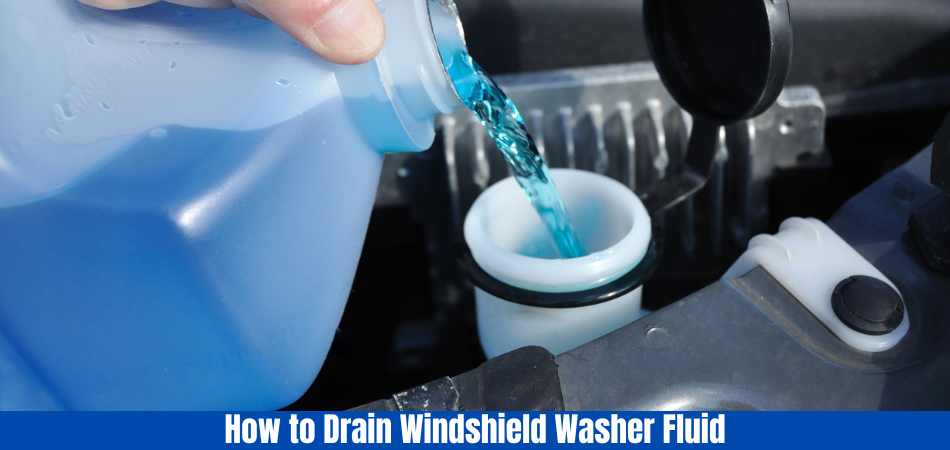
2. A slower wiper blade
The wipers on your windshield may move slower than usual if the washer fluid is not properly lubricating them. Over time, this can lead to the blades wearing down and eventually needing to be replaced.
3. The windshield sprayed with no fluid.
An ineffective windshield washer is most evident by this symptom. Generally, if you can’t see any fluid spraying onto your windshield, your washer pump isn’t working. You may experience this problem if your pump clogged or your fuse has blown.
4. Activating the system does not engage the pump.
If the windshield washer pump does not engage when you activate the system, it could indicate a faulty relay switch. When the system activated, this switch turns on the pump, so the pump will not start if it is malfunctioning.
5. Not moving wiper blades.
In addition, wiper blades that do not move when the system turned on are another sign of a wrong windshield washer. Several factors can cause this, including blown fuses or faulty relays.
If you notice any of these symptoms, a professional should consulted as soon as possible.
You may be unable to clean your windshield correctly, or your wiper blades may have been damaged if you ignore these symptoms.
How to Drain Windshield Washer Fluid?
Step 1: Obtain the necessary materials and tools
The necessary tools and materials are essential before draining the windshield washer fluid. You will need the following:
- Protective gloves
- Glasses for safety
- Dispose of old washer fluid in a container
- A funnel
- The windshield washer fluid needs to replace
Safety glasses and protective gloves are essential to ensure safety during the process. Since you will be draining the washer fluid from the reservoir, it’s also essential to use a large container to hold it.
It’s time to move on to the next step after gathering all the necessary tools and materials.
Step 2: Find the reservoir for the windshield washer fluid
Identify your vehicle’s windshield washer fluid reservoir next. Typically, windshield washer fluid stored in a translucent plastic reservoir. Near the windshield, it is usually located near the front of the engine bay.
Please refer to your vehicle’s owner’s manual for specific instructions on locating the reservoir. Finding the reservoir made more accessible by the detailed information and illustrations provided in the manual.
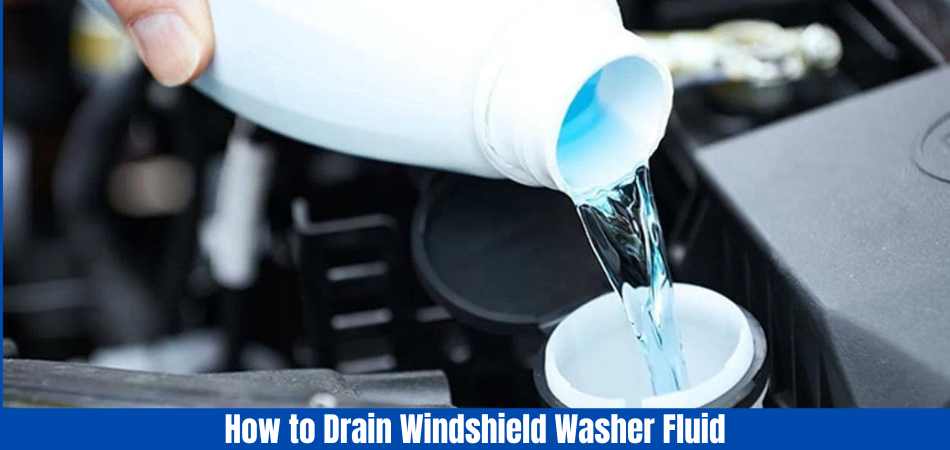
Ensure you inspect the reservoir for cracks or leaks once you’ve found it. A damaged reservoir may need to be replaced if you notice any damage.
The next step is to drain the old windshield washer fluid after you have located and inspected the reservoir.
Step 3: Dispose of the old windshield washer fluid
It’s time to remove the old windshield washer fluid from the reservoir now that you have located it. This process can be completed by following these steps:
- Secure your vehicle’s hood using the prop rod or hood latch.
- Check the reservoir for a cap or a screw-on lid. You can remove the cap by twisting it counterclockwise. The lid may need to be unscrewed with a wrench or appropriate tool if it has a screw-on design.
- Position the container you prepared in Step 1 beneath the reservoir.
- A drain plug or drainage tube should be attached to the bottom of the reservoir. Allow the old fluid to drain into your container by removing the plug or disconnecting the tube.
- Allow the fluid to drain completely. Ensure all the liquid is removed by tilting or shaking the reservoir slightly.
- Drain the reservoir and reconnect the drain plug or drainage tube once emptying it.
After following these steps, your vehicle is now free of old windshield washer fluid. Removing the old fluid is the next step now that we’ve removed the old fluid from the system.
Step 4: Properly dispose of the old fluid
Protecting the environment requires proper disposal of old windshield washer fluid. The following are some tips for disposing of it responsibly:
- For disposal of automotive fluids, check local regulations: Different regions may have different guidelines. Learn more about the proper disposal methods in your area by contacting your local waste management authority or environmental agency.
- You can recycle automotive fluids at a local recycling facility. Fluids can be handled and recycled safely at these facilities.
- Don’t pour old washer fluid down drains or into the ground. Water sources can be contaminated, and the environment can be harmed.
- Prevent leaks and spills before transporting the old fluid to the recycling facility by sealing the container securely.
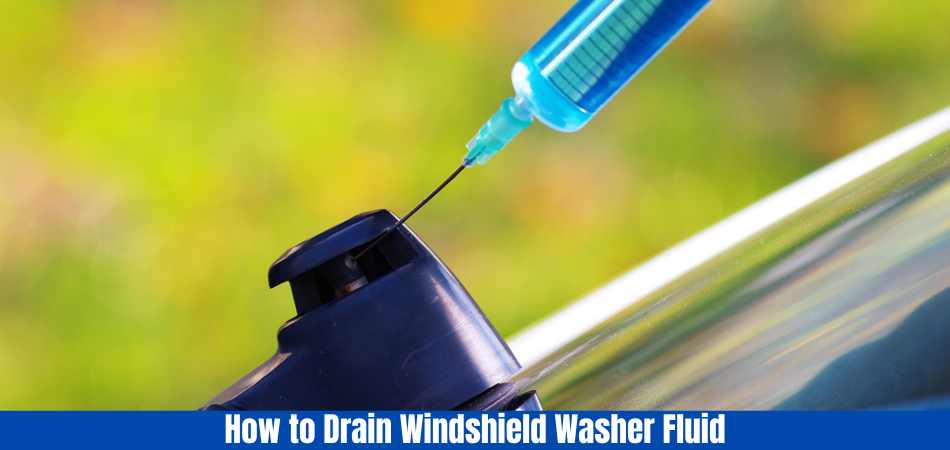
Ensure the safety of our communities and our environment by properly disposing of automotive fluids. It is possible to contribute to a cleaner and greener planet by following these steps.
After responsibly disposing of the old fluid, We will refill the reservoir with new windshield washer fluid.
Step 5: Fill the reservoir with windshield washer fluid
You are now ready to refill the reservoir with fresh windshield washer fluid after properly disposing of the old fluid. This process can be completed by following these steps:
- Ensuring that the drain plug or drainage tube is securely attached to the reservoir is essential.
- Pour your new windshield washer fluid into the reservoir carefully.
- Make accurate pouring easier by using a funnel to avoid spills.
- Just below the reservoir’s top or up to the indicated fill line, fill the reservoir with water.
- Do not overfill the container, as this may result in leaks.
- The cap or screw-on lid should be securely replaced once the reservoir has been filled.
- You should use a windshield washer fluid that is appropriate for your vehicle. The type of washer fluid you choose should determined by factors such as the climate in your area.
Now that the reservoir has been refilled with new windshield washer fluid, we can test the windshield washer system.
Step 6: Check the windshield washers
Whenever you refill a windshield washer reservoir with fresh fluid, you should test the system to ensure everything works. You can test the windshield washer system by following these steps:
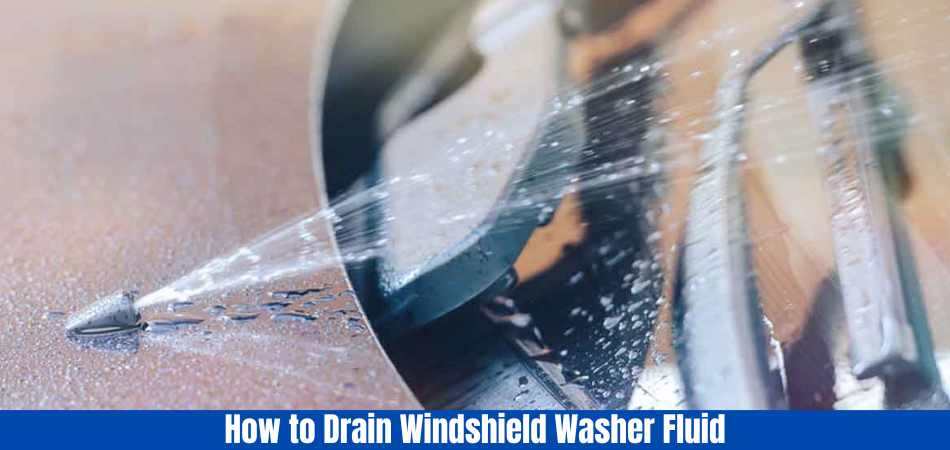
- The windshield wipers should activated as soon as you start your vehicle.
- Press the washer fluid lever or button to engage the windshield washer system.
- Take note of how the washer fluid is flowing and the spray pattern. To cover the windshield adequately, it should spray evenly.
- If the spray pattern is weak or uneven, there may be a clogged nozzle or a problem with the pump. A professional may assist you in such cases by cleaning the nozzles.
- If You’re all set now that the system is working correctly! Keeping your windshield clear is easy with your windshield washer system.
- Keeping the windshield washer fluid level topped up is a good practice. When you maintain your vehicle regularly, you’ll always be able to see clearly while driving.
Your vehicle’s windshield washer fluid drained and refilled after the windshield washer system was successfully tested. Best wishes!
When Should Windshield Washer Fluid Be Drained?
In the same way, fuel isn’t used indefinitely, windshield washer fluid isn’t. If necessary, you should inspect and replace it. Liquid solutions are corrosive due to their nature. As a result, other washing system components will break down over time. As a result, other washing system components will break down over time. You’ll have to drain the windshield washer fluid for safety so it won’t hinder your view.
The windshield will get distort if you don’t drain it for an extended period. When using a superior cleaning solution or if you are unfamiliar with the kind you are using, you should also drain the wiper.
The windshield washer fluid can be emptied and replaced with a fresh one if it is small or low. You may want to replace your windshield washer fluid every time your car serviced, when the climate changes, or when it becomes tired.
You may do so to clean the dust and debris from your windshield. However, it will limit the longevity of glass-washing solvent replacement. The liquid needs to change after you have cleaned insects in the summer. Windshield washer fluid also has many benefits you may find interesting.
What Should You Do When Your Wiper Fluid Is Frozen?
STEP 1: Mix the liquids
Creating a mixture is the first step in preventing the liquid from freezing. De-icer fluid products can add to the washer, or Methyl Hydrate can be used as a de-icer fluid.
Nevertheless, ensure the mixture is not too dilute so as not to affect the liquid’s quality.
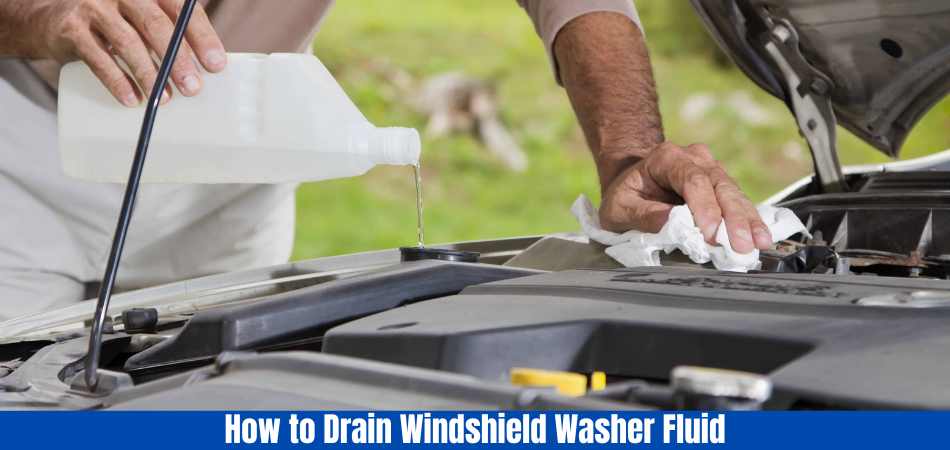
STEP 2: Put fuel in the tank
Pour the mixture along with the deicing agent into the container after it has been mixed. As a result of this liquid, the windshield washer fluid won’t freeze in the winter and will work as expected.
STEP 3: Clean the wiper blades
Wipe the wiper blades with the mixed solution and remove any ice using a rag.
The wiper blades will then de-ice the windshield if you gently turn the washing solution so that it works on the windshield. When using wiper blades and cleaning solution, this solution will remove any ice that builds up.
Can You Mix Windshield Washer Fluid?
The windshield washer fluid can mix with the formula to make two similar products.
It is common for Rain-x glass cleaning fluid to produce through separate processes, for example. As a result, mixing it with other cleaning agents can adversely affect one of the products.
In addition, your glasses won’t benefit from the original liquid’s benefits.
Because you don’t use chemicals, mixing windshield washer fluid won’t cause a fire or explosion. Despite this, you cannot clean the glass thoroughly if the components are not mixed properly.
There is not only a lack of thorough cleaning on your windshield, but it is also dirtier than before.
How To Unclog The Nozzle On The Windshield?
If you hear the pump running, you may have a clogged windshield washer nozzle, but the water won’t flow. The debris inside can blown out using compressed air after you unscrew it with a pin.
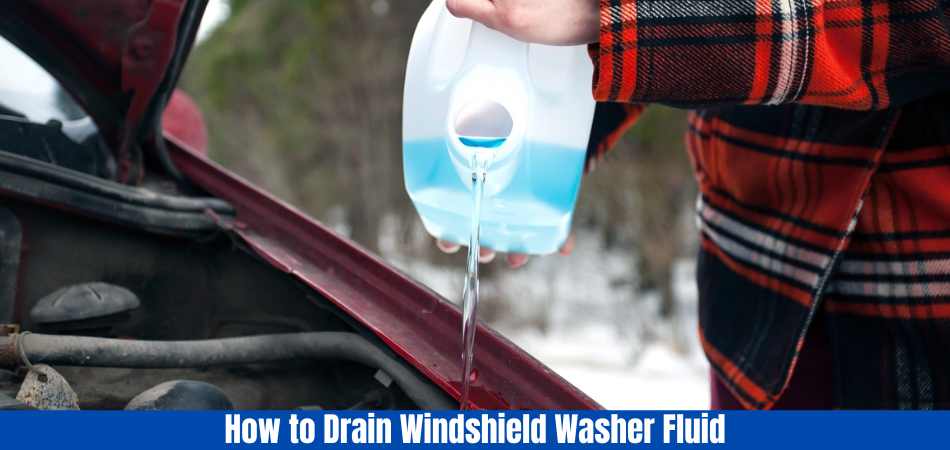
You only need to lift your car’s hood and inspect the washer hose from the nozzle to the reservoir. You should see a round check valve or a plastic or barbed wire connector.
The washing machine must then restarted after you disconnect the pipe.
If liquid spews out from the nozzles, they plugged in. Clean the nozzle by pushing a small pin to loosen the dirt. Once the blockage removed from the tube, you blow it back into it.
Is it Safe to Add Rubbing Alcohol To The Windshield Washer Fluid?
In winter, add rubbing alcohol to your laundry detergent mix to make de-icing fluid. Commercial washing machine liquid is expensive, so making your de-icing mix is a cost-effective alternative.
Mixing water and alcohol is the first step. Mix 1 gallon of distilled water with approximately 8 ounces of rubbing alcohol.
Instead of dish soap, you add castile soap, which contains more natural ingredients and is safer for your paint job.
The liquid will not freeze in areas with colder temperatures if you increase the amount of alcohol.
The homemade mixture should be tested on the windshield before it poured into the tank. To wipe off your car’s windshield, use a clean cloth soaked in the above mixture.
Conclusion
The process of draining windshield washer fluid from your automobile might be challenging. As a result, we’ve emphasized the guidance above with care, and we hope it helps you understand how to drain windshield washer fluid. We appreciate your presence at the end, friends. If you want to add soap to a pressure washer, read about what oil to use.
Read More of Our Articles Here.
Read Also: All You Need to Know About Washer Fluid.
FAQs
What is the purpose of draining windshield washer fluid?
When changing windshield washer fluid type, replacing contaminated solution, or performing maintenance on the washer fluid system, you must drain the fluid.
When should I drain and replace windshield washer fluid?
You should replace windshield washer fluid once a year at the very least. In the event of discoloration, debris, or an unpleasant odor, you should drain and replace it as soon as possible.
Is there a tool I need to drain windshield washer fluid?
It is usually necessary to use a screwdriver, an old fluid container, and perhaps a pair of pliers to do this. If you need any specific tools, check the manual of your vehicle.
Is it okay to drain the windshield washer fluid myself or should I hire a professional?
Most car owners can drain their windshield washer fluid easily. You can do it yourself by following safety measures and using the right tools.
What is the location of the reservoir for windshield washer fluid?
Different vehicles have different locations for the reservoir, but it is usually a translucent container with a windshield symbol on the cap. You can find the exact location in the owner’s manual of your vehicle.










Leave a Reply